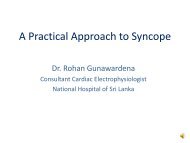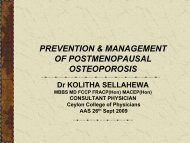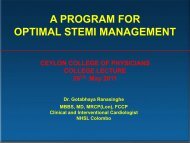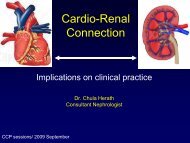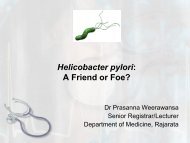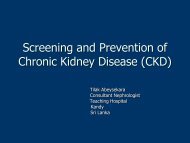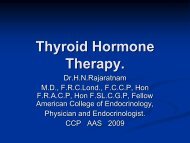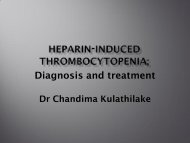Urinary Disorders in elderly Women
Urinary Disorders in elderly Women
Urinary Disorders in elderly Women
- No tags were found...
You also want an ePaper? Increase the reach of your titles
YUMPU automatically turns print PDFs into web optimized ePapers that Google loves.
<strong>Ur<strong>in</strong>ary</strong> <strong>Disorders</strong>• Related to <strong>in</strong>fection• Related to oestrogen deficiency• Related to cont<strong>in</strong>ence
Lower <strong>Ur<strong>in</strong>ary</strong> Tract DysfunctionRelated to Cont<strong>in</strong>ence• Abnormalities of storage and fil<strong>in</strong>g phase• Abnormalities of the void<strong>in</strong>g phase• Comb<strong>in</strong>ation of the above two
Incont<strong>in</strong>ence• <strong>Ur<strong>in</strong>ary</strong> <strong>in</strong>cont<strong>in</strong>ence is the uncontrollable leakage ofur<strong>in</strong>e.• It is more common <strong>in</strong> the <strong>elderly</strong>• <strong>Ur<strong>in</strong>ary</strong> <strong>in</strong>cont<strong>in</strong>ence is not a natural process ofage<strong>in</strong>g.
Types of Incont<strong>in</strong>ence• Stress Incont<strong>in</strong>ence ( leakage of ur<strong>in</strong>e when you cough,sneeze, laugh or lift someth<strong>in</strong>g heavy)• Urge Incont<strong>in</strong>ence (leakage of ur<strong>in</strong>e before you canreach a toilet)• Overflow Incont<strong>in</strong>ence (Inability to stop ur<strong>in</strong>e fromconstantly dribbl<strong>in</strong>g out; full bladder but you havedifficulty empty<strong>in</strong>g it completely )• Functional Incont<strong>in</strong>ence (<strong>Women</strong> with cognitive,psychological and physical impairment)• Fistula ( A false connection between the bladder or theureter to the vag<strong>in</strong>a )
HistoryEvaluation of ur<strong>in</strong>ary symptoms1) Do you leak ur<strong>in</strong>e with activities such aslaugh<strong>in</strong>g, sneez<strong>in</strong>g, cough<strong>in</strong>g, and/or exercise?2) Are there times when you have the urge to ur<strong>in</strong>ate but leak before you get tothe bathroom?3) Do you leak ur<strong>in</strong>e daily, weekly, monthly, or less than once a month?4) When you leak would you characterize the loss as drops, small splashes, ormore than small splashes?5) Do you wear protective pads, and if so, how many per day?6) How often do you get up at night to ur<strong>in</strong>ate?7) How many times do you void dur<strong>in</strong>g the course of the day?8) Do you ever leak without a preced<strong>in</strong>g urge or stress?9) Do you ever feel that you do not completely empty your bladder?10) Do you have bladder pa<strong>in</strong> or pa<strong>in</strong> with void<strong>in</strong>g?
HistoryCo morbid Factors• Medical – Diabetes, Stroke, chronic lung disease,obesity, cognitive impairment• Surgical - Hysterectomy,vag<strong>in</strong>al or bladder surgery• Obstetric - Parity, vag<strong>in</strong>al deliveries, <strong>in</strong>tervalbetween pregnancies• Gynaecological – Pelvic organ prolapse• Oestrogen status• Trauma
Drugs That Affect <strong>Ur<strong>in</strong>ary</strong> FunctionDRUGAlpha-adrenergic blockersAlpha-adrenergic agonistsBeta-adrenergic agonistsCalcium channel blockersAntidepressants,antipsychoticsAntichol<strong>in</strong>ergicsNarcoticsDiureticsCaffe<strong>in</strong>eAlcoholSIDE-EFFECTDecrease urethral toneIncrease urethral tone, ur<strong>in</strong>aryretentionInhibited detrusor function,ur<strong>in</strong>ary retention<strong>Ur<strong>in</strong>ary</strong> retention<strong>Ur<strong>in</strong>ary</strong> retention<strong>Ur<strong>in</strong>ary</strong> retention<strong>Ur<strong>in</strong>ary</strong> retention<strong>Ur<strong>in</strong>ary</strong> frequency and urgency<strong>Ur<strong>in</strong>ary</strong> frequency and urgency<strong>Ur<strong>in</strong>ary</strong> frequency and urgency
Evaluation• Bladder diary• 24 hour record• Type and amount of fluid consumed• Number and volume voids• Leaks <strong>in</strong> each hour• Activity engaged at the time of leak
Exam<strong>in</strong>ation• General - Obesity• CVS• Respiratory• CNS• Abdom<strong>in</strong>al – masses, ascites• Pelvic – <strong>in</strong>flammation, <strong>in</strong>fection, atrophy, oestrogenstatus, urethra, uterus, adnexa, pelvic muscle toneand strength• Per rectal exam<strong>in</strong>ation – fecal impaction, occult blood
Investigations• MSU for ur<strong>in</strong>alysis• Ur<strong>in</strong>e for culture & ABST• Cystoscopy (If <strong>in</strong>dicated)• Pyridium test (bright Orange ur<strong>in</strong>e)• Simple cystometry• Multi channel subtracted cystometry• Vedio cystometry• Ultrasound evaluation
Treatment• Conservative management• Behavioral modifications• Pelvic floor exercises• Medical management (Drugs)• Electrical stimulation• Magnetic beam stimulation• Surgical Treatment• Colposupension• Tension free Vag<strong>in</strong>al Tape (TVT and TVT O )• Periurethral <strong>in</strong>jection of bulk<strong>in</strong>g agents
Behavioral Modification• Dr<strong>in</strong>k 6-8 glasses of water daily unless your doctor has <strong>in</strong>structedotherwise.• Limit your <strong>in</strong>take of alcohol and caffe<strong>in</strong>ated dr<strong>in</strong>ks.• Take a balanced diet that <strong>in</strong>cludes all food groups and keep with<strong>in</strong> ahealthy weight range.• Include enough fluid and fibre <strong>in</strong> your diet and exercise regularly toprevent constipation that can lead to poor bladder control.• Practice good bladder habits by regularly empty<strong>in</strong>g your bladder.Hold<strong>in</strong>g back for too long when a bladder is full, or persistentlyempty<strong>in</strong>g it when it is not, can both cause abnormal bladder function.Bladder retra<strong>in</strong><strong>in</strong>g• Do pelvic floor exercises regularly to strengthen the musclessupport<strong>in</strong>g the outlet of the bladder.• Avoid precipitat<strong>in</strong>g factors such as obesity, chronic cough, sneez<strong>in</strong>gand heavy lift<strong>in</strong>g etc.
Stress Incont<strong>in</strong>ence• Non Surgical• Pelvic floor exercises• Surgical• Colposupension• Tension free Vag<strong>in</strong>al Tape (TVT and TVT O )• Periurethral <strong>in</strong>jection of bulk<strong>in</strong>g agents
Overactive Bladder(Urgency,Frequency,Urge Incont<strong>in</strong>ence)• Detrusor Instability (Idiopathic)• Detrusor hyperreflexia (Due to known neurologiccondition)
Overactive Bladder -Treatment• Bladder retra<strong>in</strong><strong>in</strong>g• Electrical stimulation (Sacral nerve root Neuromodulation)• Stimulate pelvic floor and urethral muscles, <strong>in</strong>hibitsdetrusor contractility• Pharmacologic management• Antichol<strong>in</strong>ergic agents• Oxybutyn<strong>in</strong> chloride• Tolterod<strong>in</strong>e (Bladder selective, less systemic side effects)• Tricyclic Antidepressants• Imipram<strong>in</strong>e hydrochloride (Improves bladder storage andhypertonicity)• Synthetic vasopress<strong>in</strong>• DDAVP (Decreases ur<strong>in</strong>e production, use with caution <strong>in</strong> <strong>elderly</strong>)
Overflow Incont<strong>in</strong>ence• Due to outlet obstruction(Prolapse,Stricture) orunderactive detrusor muscle (Diabetic neuropathy,multiple sclerosis,sp<strong>in</strong>al cord <strong>in</strong>jury,radical pelvicsurgery)• Surgical treatment only to relieve obstruction• Intermittent self-catheterization• Treat the underly<strong>in</strong>g etiology
Cystitis• Bacterial• MSU culture and sensitivity• Appropriate ur<strong>in</strong>ary antiseptics• Non-bacterial• Local estrogen• Antichol<strong>in</strong>ergics• Urethral dilatation
<strong>Ur<strong>in</strong>ary</strong> Disorder• Problem of <strong>in</strong>cont<strong>in</strong>ence• Problem of bladder irritability• Structural problem• Inflammatory• Psychogenic
Thank You




